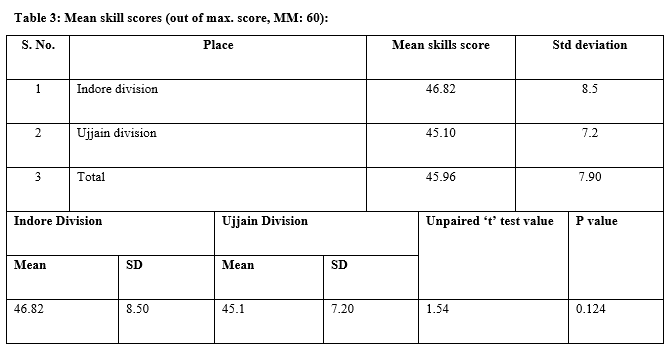A cross sectional study to evaluate the operational skills of asha in randomly selected districts of indore & ujjain division
Abstract
Background: ASHA have been introduced to fill the void created by overburdening of work of anganwadi workers, who employed under the ICDS, are engaged in organizing supplementary programs. The key tasks for the next phase of the NRHM are to equip the ASHA with additional skills to enable an active role for her in not just Reproductive and Child Health but also to undertake action for prevention. Community level cares for Non-communicable Diseases should be encouraged.
Methods: A cross sectional study was conducted in randomly selected two districts each from Indore and Ujjain divisions of the state of Madhya Pradesh. 100 ASHAs (Accredited Social Health Activists) and 50 ANMs (Auxiliary Nurse Midwife) were the study population. Data was collected with the help of semi structured questionnaire and Performa for skill evaluation.
Results: Hand washing was performed by 93% participants, 67% were table to take proper temperature recording, 57% were able to weight newborns, 87% were able to apply eye ointment, 53% were able to cover the newborn with the blanket and 38% were able to keep the newborn in warm bag. Mean skill score of Indore and Ujjain Divisions came to be nearly equal and had no significant difference (Unpaired t test, p > 0.05).
Conclusion: Quality of training had a positive effect on knowledge, skills and activities undertaken by ASHAs. The work done by ASHAs was mostly focused on incentives; they were giving priorities to activities with good incentives over other activities.
Downloads
References
2. Government of India. National Rural Health Mission (2005-2012) Mission Document. New Delhi: Ministry of Health and Family Welfare, 2005.available at http//www. Mohfw.nic.in/NRHM/mission document .pdf.
3. Nirupam Bajpai and Ravindra H. Dholakia Working Paper No. 1 May 2011 “Improving the performance of accredited social health activists in India”
4. Smitha Kochukuttan, TK Sundari Ravindran, Suneeta Krishnan. Evaluating Birth Preparedness and Pregnancy Complications Readiness Knowledge and Skills of Accredited Social Health Activists in India, International Journal of MCH and AIDS (2013), Volume 2, Issue 1, Pages 121-128
5. Shrivastava, S.R, & Shrivastava, P.S (2012). Evaluation of trained accredited social health activist (ASHA) workers regarding their knowledge and attitude and practice about child health. Rural and Remote Health, 12(4): 2099 (online) available: http://www.rrh.org.au.
6. Patel T, Raval D, Pandit N. Process evaluation of routine immunization in rural areas of Anand District of Gujarat. Healthline 2011; 2(1): 17.
7. Jain N, Srivastava NK, Khan AM, Dhar N, Manon S, Adhish V, Nandan D. Assessment of functioning of ASHA under NRHM in Uttar Pradesh. Health and Population: Perspectives and Issues. 2008; vol 31 (2): 132-140.
8. Swain S, Swain P, Nair KS, Dhar N, Gupta S, Nandan D. A rapid appraisal of functioning of ASHA under NRHM in Orissa. Health and Population: Perspectives and Issues 2008; 31(2): 73-79.
9. Haider S, Adhish SV, Gupta S, Dhar N, Datta U, Menon S et al. A rapid appraisal of SAHIYA (ASHA) in Jharkhand. Health and Population: Perspectives and Issues 2008; 31(2): 80-84.
10. Janet Brandling et al “Evaluating Mental Health First Aid Training for Line Managers working in the public sector” Mental Health First Aid Training Evaluation March 2010, available at http://mhfaengland.org/files/6113/9031/3941/2010_Bath_Uni_MHFA_Final_Report.pdf
11. Foreman, P. & Gardner, I. (2005). Evaluation of Education and Training of Staff in Dementia Care and Management in Acute setting. Report for the Department of Human Services, April 2005,available at http://www.voced.edu.au/content/ngv%3A61349
12. Bhatt Hema, a rapid appraisal of functioning of ASHA under NRHM in Uttarakhand, India, May 2012. Assessed through : http://cooperation.epfl.ch/page-91580-fr.html
13. Garg PK, Bhardwaj A, Singh A, Ahluwalia SK. An Evaluation of ASHA Worker’s Awareness and Practice of their Responsibilities in Rural Haryana. National J Community Med 2013; 4(1): 76-80.
14. Sangeeta Kansal, Santosh Kumar, Alok Kumar. Is educational level of ASHA matters for their effective functioning? A cross- sectional study in eastern Uttar Pradesh, Indian Journal of Community Health ISSN/EISSN: 09717587 22489509 Year: 2012 Volume: 24 Issue: 1 Pages: 41-44
15. Bhatnagar R, Singh K, Bir T, Datta U, Raj S, Nandan D. An assessment of performance based incentive system for ASHA Sahyogini in Udaipur, Rajasthan. Indian J Public Health 2009; 53(3):166-70.
16. Shree Roy, Biswamitra Sahu. Can ASHA be the ray of hope for providing MCH services in Odisha, India? Exploring through a qualitative study.Journal of global health care Systems/volume 3, number 2, 2013.

Copyright (c) 2016 Author (s). Published by Siddharth Health Research and Social Welfare Society

This work is licensed under a Creative Commons Attribution 4.0 International License.


 OAI - Open Archives Initiative
OAI - Open Archives Initiative


